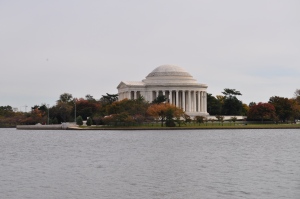Rome by the Potomac
by lowepj33
It’s been a while since I’ve posted anything here, and for that I can only mumble something about the mid-term marking load by way of apology and aspire to better habits in the future. I can also, though, take the opportunity to recall my recent US trip and its potential relevance for the classical / modernist direction of my research at the moment. So, here goes.
I was actually in the US to participate in this year’s Modernist Studies Association conference in Pittsburgh: 4 days of papers, seminars, discussions and coffee consumption hosted in style in the city’s William Penn Hotel, the 1920s décor of which led me to expect to see Fred and Ginger dancing across the lobby at any moment while I waited for the lift to the 17th floor. On my way there, though, I stopped off to visit friends just outside Washington DC and had the chance to enjoy the city in some glorious early-autumn sunshine.
Of course there was the usual sightseeing itinerary: a tour of the Capitol building (always good for a ‘House of Cards’ viewer!) the wonderful National Gallery of Art, and the museums of the Smithsonian where I got to see everything from the Apollo 11 command module to Julia Childs’ kitchen in the course of 2 very footsore days.
Above all, though, my focus was the National Mall and its remarkable assembly of monuments, from the Washington obelisk to Lincoln’s neo-Greek temple where he sits “enshrined for ever”, to the Vietnam Wall’s starkly powerful list of names, and the Jefferson Memorial’s marble replica of Rome’s Pantheon set down by the Potomac’s tidal basin. To walk between these immense sites was, for me, a chance to consider the purpose of memorialisation and the power of the ideas and events that each space sets apart in the viewer’s mind. And I was, more than ever, intrigued by the fact that these monumental structures are, in the main, very modern creations. The Lincoln Memorial, so classical in its harmony, was completed in 1922, the same year that saw T. S. Eliot’s ‘The Waste Land’ and James Joyce’s ‘Ulysses’, and the Jefferson Memorial was completed in the midst of World War 2. In the formative years of the 20th century, then, the world’s pre-eminent power chose as its language of grandeur the style of the Roman world that its founding fathers had held so dear in their imaginations. And it looks so good that, for a moment, one wonders what an archaeologist of the future would make of a city where a Roman temple, its deity replaced by a bronze statue of the man who drafted the Declaration of Independence, stands proudly about a mile from a building that houses the craft that sent men to the Moon. To be in that city in the week of the Mid-term elections, when once again there was talk of who would hold power on Capitol Hill (not the first time people have pondered that topic, I’m sure!) was an experience that certainly gave me much to think about in terms of Rome’s lasting legacy.

